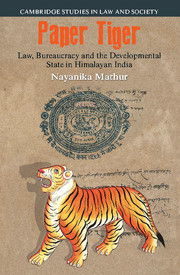6 - The Reign of Terror of the Big Cat
from Paper Tiger?
Published online by Cambridge University Press: 05 October 2015
Summary
It was an ordinary morning in late November in the NREGS cell. I was struggling to decipher the contents of a file while the other four members of the office busily worked on documents of all sorts. The cold had frozen all conversation. All of a sudden, a man burst into the room to announce dramatically: ‘The bagh (leopard) has returned!’ My office-mates gasped aloud in horror. Our informant rapidly recited his story: a woman had been climbing to the top of the mountain on which Gopeshwar is located to collect some grass for her goat. Out of the blue a bagh leapt upon her, horribly lacerating her face. Screaming in agony and terror, she fell down the steep slope. Her screams attracted the attention of other people nearby, who started making a noise, scaring the bagh so that, in a trice, he had vanished into the bushes. Mercifully, this attack had not proven fatal but the bad news, I was told solemnly, was that the bagh had returned to haunt the little town of Gopeshwar again. Everyone in the district office came out of their rooms to talk about the ‘return of the bagh’ in hushed and horrified tones.
Years before that November morning, I had read what I had then merely considered thrilling bed-time stories – the Man-eaters of Kumaon and the Man-eating Leopard of Rudraprayagpenned by the hunter-turned-conservationist Jim Corbett. Corbett's books were set in the early part of the twentieth century, which had led to my assumption that incidents of man-eating leopards and tigers were not (surely could not be?) really frequent in this region anymore. On the drive up to Gopeshwar, I had passed the shrine erected on the very spot where Corbett had killed the famous man-eating leopard of Rudraprayag (Figure 6.1). Despite this prominent landmark erected in proximity to Chamoli, at no point during my initial research on the district had anyone told me about the bagh, nor had I found any written references to what I was now learning was an endemic feature of life in this district. I was, therefore, confounded by all this bagh-talk. As I had an interview scheduled with a senior official in the district, I could not stay for long but hurried over to his office.
- Type
- Chapter
- Information
- Paper TigerLaw, Bureaucracy and the Developmental State in Himalayan India, pp. 140 - 164Publisher: Cambridge University PressPrint publication year: 2015



